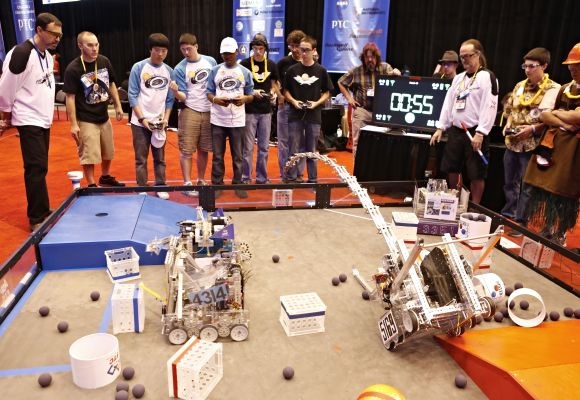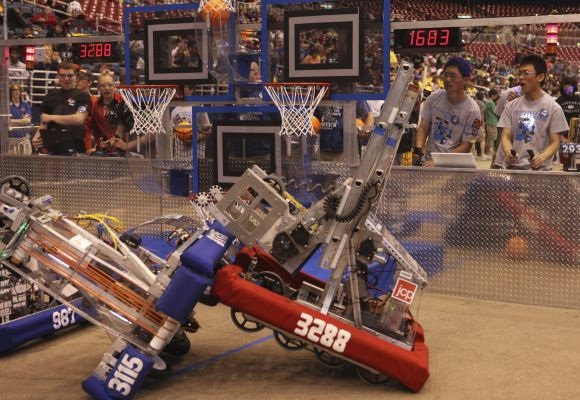Last December, Jim Harrison wrote about hearing Dean Kamen talk about the nonprofit organization FIRST, whose mission is to inspire young people to be science and technology leaders. Then in February, he interviewed Paul Koniarski, an electronics engineer at Qualcomm, about his experience as mentoring for FIRST at Hilltop High School in Chula Vista, CA.
To continue this series, we'd like to take a deeper look into how FIRST is organize to interact with kids. The program has been developed to address the need of students from ages 6 to 18 with a progression of four programs: Junior FIRST LEGO League (Jr.FLL), FIRST LEGO League (FLL) FIRST Tech Challenge (FTC), and FIRST Robotics Competition (FRC). Each program is designed to be age appropriate for the groups it addresses, and a student can join an age-appropriate group without having previously been a member of a group designed for younger students.
All the annual programs are designed to culminate in an international robotics competition and celebration, where teams will hopefully win recognition, gain self-confidence, develop people- and life-skills, make new friends, and perhaps even discover an unforeseen career path. In the following paragraphs, we'll look at how each program is designed to be set up.
Junior FIRST LEGO League (Jr.FLL)
Focused on children ages 6 through 9, Jr.FLL is a hands-on program designed to capture young children's inherent curiosity and direct it toward discovering the possibilities of improving the world around them through science and technology. Each year, the program features a real-world challenge to be solved by research, critical thinking, and imagination. Guided by adult coaches and the Jr.FLL Core Values, students work with LEGO bricks and moving parts to build ideas and concepts and present them for review.

The challenge has two parts: the LEGO Model which the team constructs and the Show MePoster they create to explain their project. Working in teams of two to six children and guided by at least one adult coach, teams work to complete their challenge. For many teams, the culmination of the hard work is participation in a Jr.FLL event. The FIRST Program provides guidelines for how these events should be conducted. Volunteer Reviewers at the event interview the teams to learn about their LEGO Model and Show Me poster. All the teams are celebrated and leave with an award.
FIRST LEGO League (FLL)
Open to pre-high-school children (9 to 14 in the U.S., Canada, and Mexico; 9 to 16 in other countries), the FLL is designed to immerse kids in real-world science and technology challenges. As with the Jr. FLL, teams design their own solution to a current scientific question or problem. But in this case, they must build autonomous LEGO robots that perform a series of missions. The goal is for the children to develop valuable life skills and discover exciting career possibilities, while learning that they can make a positive contribution to society.

FIRST Tech Challenge (FTC)
FTC is designed for students in grades 7 to 12 who want to compete head to head using a sports model. Teams of up to 10 students are responsible for designing, building, and programming robots to compete on a 12 x 12-ft field against other teams. The robots are built using a TETRIX platform that is reusable from year to year, and can be programmed in a variety of languages. Teams, including coaches, mentors, and volunteers, are required to develop strategy and build robots based on sound engineering principles. Awards are given for the competition as well as for community outreach, design, and other real-world accomplishments. The competitions lead up to a World Championship, and students qualify for over $11 million in college scholarships.

FIRST Robotics Competition
Intended for high schoolers in grades 9 through 12 (14 to 18 years old), the FIRST Robotics Competition (FRC) combines the excitement of sport with the rigors of science and technology, and has been dubbed a “Varsity Sport for the Mind.” Under strict rules, limited resources, and time limits, teams of 25 students or more are challenged to raise funds, design a team “brand,” hone teamwork skills, and build and program a robot to perform prescribed tasks against a field of competitors. It's as close to “real-world” engineering as a student can get. Professional mentors volunteer their time and talents to guide each team. The teams compete to earn a place in the Championship and qualify for over $16 million in college scholarships.

So the FIRST programs provide opportunities for all pre-college children in a way that's appropriate to their age and abilities. And while not every FIRST student will go on to enter engineering school, they will at least become adults with a better understanding of science and technology and the impact it can have on society.
Advertisement
Learn more about Electronic Products Magazine





